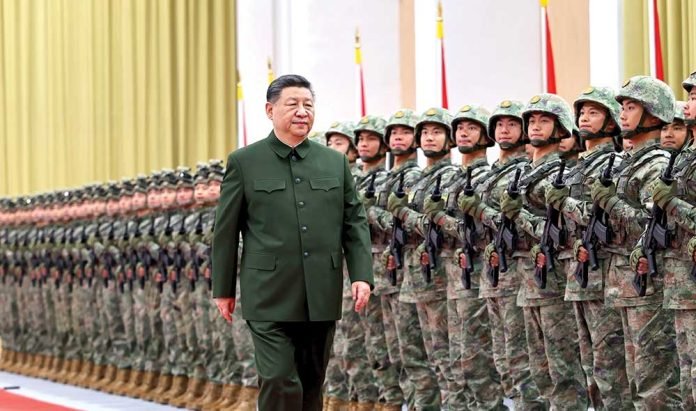China’s defence expenditure has been on a consistent upward trajectory, reflecting its strategic ambitions and growing geopolitical assertiveness. In 2025, China announced a 7.2 per cent increase in its defence budget, bringing it to approximately US$246 billion. This marks the tenth consecutive year of robust growth in military spending, underscoring Beijing’s commitment to modernising its armed forces and expanding its influence, particularly in the Indo-Pacific region.
This expansion directly affects India’s strategic environment. Both nations share a complex history characterised by territorial disputes, notably the Galwan Valley conflict in 2020. China’s increased military budget and enhanced capabilities along the Line of Actual Control (LAC) pose serious strategic challenges for India, raising concerns about future assertiveness or potential conflicts.
Moreover, China’s growing naval influence in the Indian Ocean region further complicates India’s security landscape. China has established overseas bases, notably in Djibouti, and regularly deploys naval assets in areas traditionally under Indian influence. This development significantly pressures India to recalibrate its maritime security strategies and bolster its naval capabilities.
China’s Defence Budget: Trends and Strategic Objectives
China’s defence budget has seen substantial increases over the past decade. In 2015, the budget was approximately US$141 billion, and by 2025, it surged to US$246 billion, representing a 74 per cent increase over ten years. This consistent growth reflects China’s focus on enhancing its military capabilities across various domains, including land, sea, air, space, and cyber.
India and China share a complex history characterised by territorial disputes. China’s increased military budget and enhanced capabilities along the LAC pose serious strategic challenges for India, while raising concerns about potential conflicts. Moreover, China’s growing naval influence in the Indian Ocean region further complicates India’s security landscape
Several factors drive China’s escalating defence expenditure
- Modernisation of the People’s Liberation Army (PLA): China aims to transform the PLA into a world-class military force by 2049, coinciding with the centenary of the People’s Republic. This involves upgrading equipment, improving training and readiness, and integrating advanced technologies.
- Regional Influence and Territorial Claims: China’s assertiveness in the South China Sea, its stance on Taiwan, and border tensions with neighbouring countries necessitate a formidable military presence to support its geopolitical objectives.
- Countering US presence in Asia: As the United States strengthens alliances and military deployments in the Asia-Pacific, China perceives a need to bolster its capabilities to deter and respond to potential contingencies.
India’s Aatmanirbhar Bharat Initiative
In response to these challenges, India has accelerated its Aatmanirbhar Bharat initiative, aimed at achieving self-reliance in defence manufacturing. Initiated to reduce dependency on foreign imports and strengthen indigenous production, the initiative includes substantial policy reforms such as the release of positive indigenisation lists banning imports of specific defence equipment. By 2023-24, India allocated 68 per cent of its defence capital outlay towards domestic procurement, highlighting its commitment to nurturing an indigenous defence industry.
Role of Public-Private Partnerships
Public-private partnerships have also become central to India’s defence strategy. The Strategic Partnership model promotes collaboration between state-owned enterprises and private firms, aiming to build a robust industrial defence base. The Defence Research and Development Organisation (DRDO) supports innovative startups and medium-sized enterprises through schemes like the Technology Development Fund (TDF) and Innovation for Defence Excellence (iDEX), recently increasing project funding caps significantly.
Notable Achievements
India’s self-reliance journey has already recorded significant milestones. Notably, the commissioning of INS Vikrant, India’s first domestically built aircraft carrier, in 2022 was a crucial achievement in Naval capabilities. The indigenous Light Combat Aircraft (LCA) Tejas marked India’s advancements in aerospace, while the Advanced Towed Artillery Gun System (ATAGS) underscored progress in artillery systems. India’s defence export capabilities also expanded, with the Akash Surface-to-Air Missile system being exported to countries like the Philippines, marking a pivotal shift towards becoming a global defence exporter.
Implications for India’s Security Landscape
China’s expanding military prowess poses significant strategic challenges for India. The two nations share a complex history marked by border disputes and strategic competition. The 2020 Galwan Valley clash, resulting in casualties on both sides, highlighted the volatility of their border tensions. China’s increased defence spending enhances its ability to project power along the Line of Actual Control (LAC) and in the Indian Ocean Region (IOR), areas of critical importance to India’s security.

India’s Strategic Response: The Aatmanirbhar Bharat Initiative
In response to these challenges, India has embarked on the Aatmanirbhar Bharat Abhiyan (Self-Reliant India Initiative), aiming to reduce dependence on foreign defence imports and build a robust indigenous defence industry. This initiative encompasses several key strategies:
- Policy Reforms and Indigenisation Lists:The Ministry of Defence has introduced positive indigenisation lists, restricting the import of specific defence equipment to promote domestic production. As of 2025, over 500 items have been identified for indigenous manufacturing.
- Enhanced Defence Production Targets:India aims to achieve a defence production turnover of ₹1.75 lakh crore (US$23 billion) by 2025, including exports of ₹35,000 crore (US$4.6 billion).
- Public-Private Partnerships and MSME Involvement:The initiative emphasises collaboration between public sector undertakings (PSUs), private enterprises, and micro, small, and medium enterprises (MSMEs). Notably, the private sector’s share in defence production reached 22 per cent in FY2024, the highest in nearly a decade.
- Technological Innovation and R&D: Organisations like the Defence Research and Development Organisation (DRDO) play a pivotal role in developing indigenous technologies. Projects such as the Akashteer air defence control and reporting system exemplify India’s commitment to creating advanced defence systems tailored to its strategic needs.
The Aatmanirbhar Bharat initiative has made significant strides but technological gap remains a huge challenge. Certain critical technologies, such as advanced jet engines and complex weapon systems, still require foreign collaboration
Challenges in Achieving Self-Reliance
While the Aatmanirbhar Bharat initiative has made significant strides, several challenges remain:
- Technological Gaps:Certain critical technologies, such as advanced jet engines and complex weapon systems, still require foreign collaboration. Bridging these gaps necessitates sustained investment in research and development and strategic partnerships for technology transfer.
- Infrastructure and Capacity:Developing the necessary infrastructure and manufacturing capacity to support large-scale production of defence equipment is a complex endeavour. Ensuring quality control and meeting stringent standards are essential for maintaining credibility in domestic and international markets.
- Global Competition:Establishing a foothold in the global defence market requires navigating a competitive landscape dominated by established players. India must leverage its unique strengths, such as cost-effective production and a skilled workforce, to carve out a niche in this market.
Conclusion
China’s escalating defence budget serves as both a challenge and a catalyst for India. It underscores the imperative for India to enhance its defence capabilities and achieve self-reliance in defence production. The Aatmanirbhar Bharat initiative represents a strategic endeavour to build a robust indigenous defence industry, reduce dependency on imports, and position India as a significant player in the global defence arena. While challenges persist, the progress made thus far provides a strong foundation for future advancements. By fostering innovation, encouraging public-private partnerships, and investing in research and development, India can navigate the complexities of regional security dynamics and assert its strategic autonomy in an increasingly multipolar world.
The writer is Special Advisor for South Asia at Parley Policy Initiative, Republic of Korea. He is a regular commentator on the issues of Water Security and Transboundary River issues in South Asia. The views expressed are of the writer and do not necessarily reflect the views of Raksha Anirveda






